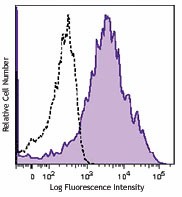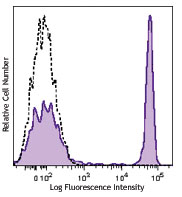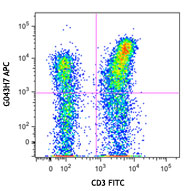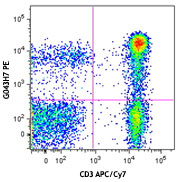- Clone
- DX2 (See other available formats)
- Regulatory Status
- RUO
- Workshop
- VI C-64
- Other Names
- Fas, APO-1, TNFRSF6
- Isotype
- Mouse IgG1, κ
- Ave. Rating
- Submit a Review
- Product Citations
- publications

-

Human peripheral blood lymphocytes were stained with CD95 (clone DX2) Brilliant Violet 421™ (filled histogram) or mouse IgG1, κ Brilliant Violet 421™ (open histogram).
| Cat # | Size | Price | Quantity Check Availability | Save | ||
|---|---|---|---|---|---|---|
| 305623 | 25 tests | 152€ | ||||
| 305624 | 100 tests | 305€ | ||||
CD95 is a 45 kD single chain type I glycoprotein also known as Fas, APO-1, and TNFRSF6. It is a member of the TNF receptor superfamily. CD95 is expressed on T and B lymphocytes, monocytes, neutrophils, and fibroblasts. CD95 expression is upregulated by activation. The extracellular region of CD95 binds to CD178 (Fas ligand). CD178 binding to CD95 induces apoptosis and has been shown to play a role in the maintenance of peripheral tolerance.
Product DetailsProduct Details
- Reactivity
- Human,Cynomolgus,Rhesus
- Antibody Type
- Monoclonal
- Host Species
- Mouse
- Immunogen
- CD95 transfected L cells
- Formulation
- Phosphate-buffered solution, pH 7.2, containing 0.09% sodium azide and BSA (origin USA).
- Preparation
- The antibody was purified by affinity chromatography and conjugated with Brilliant Violet 421™ under optimal conditions.
- Concentration
- Lot-specific (to obtain lot-specific concentration and expiration, please enter the lot number in our Certificate of Analysis online tool.)
- Storage & Handling
- The antibody solution should be stored undiluted between 2°C and 8°C, and protected from prolonged exposure to light. Do not freeze.
- Application
-
FC - Quality tested
- Recommended Usage
-
Each lot of this antibody is quality control tested by immunofluorescent staining with flow cytometric analysis. For flow cytometric staining, the suggested use of this reagent is 5 µl per million cells in 100 µl staining volume or 5 µl per 100 µl of whole blood.
Brilliant Violet 421™ excites at 405 nm and emits at 421 nm. The standard bandpass filter 450/50 nm is recommended for detection. Brilliant Violet 421™ is a trademark of Sirigen Group Ltd.
Learn more about Brilliant Violet™.
This product is subject to proprietary rights of Sirigen Inc. and is made and sold under license from Sirigen Inc. The purchase of this product conveys to the buyer a non-transferable right to use the purchased product for research purposes only. This product may not be resold or incorporated in any manner into another product for resale. Any use for therapeutics or diagnostics is strictly prohibited. This product is covered by U.S. Patent(s), pending patent applications and foreign equivalents. - Excitation Laser
-
Violet Laser (405 nm)
- Application Notes
-
The DX2 antibody is useful for inducing apoptosis of Fas-positive cells. Additional reported applications (for the relevant formats) include: in vitro induction of apoptosis3 (DX2 antibody is required to be cross-linked for effective induction of apoptosis) and immunohistochemical staining4,5 of acetone-fixed frozen tissue sections and formalin-fixed paraffin-embedded tissue sections. The Ultra-LEAF™ purified antibody (Endotoxin < 0.01 EU/µg, Azide-Free, 0.2 µm filtered) is recommended for functional assays (Cat. No. 305655 and 305656).
Note: EOS9.1 antibody can induce apoptosis without cross-linking. -
Application References
(PubMed link indicates BioLegend citation) -
- Schlossman S, et al. Eds.1995. Leucocyte Typing V. Oxford University Press. New York.
- Kishimoto T, et al. Eds. 1997. Leucocyte Typing VI. Garland Publishing Inc. New York.
- Cifone M, et al. 1994. J. Exp. Med. 180:1547. (Apop)
- Zietz C, et al. 2001. Am. J. Pathol. 159:963. (IHC)
- Sergi C, et al. 2000. Am. J. Pathol. 156:1589. (IHC)
- Xie S, et al. 2010. J. Immunol. 184:2289. (FC) PubMed
- Yoshino N, et al. 2000. Exp. Anim. (Tokyo) 49:97. (FC)
- Sestak K, et al. 2007. Vet. Immunol. Immunopathol. 119:21.
- Rout N, et al. 2010. PLoS One 5:e9787. (FC)
- Dixit N, et al. 2012. J. Immunol. 189:5954. PubMed
- Product Citations
- RRID
-
AB_10895755 (BioLegend Cat. No. 305623)
AB_2561830 (BioLegend Cat. No. 305624)
Antigen Details
- Structure
- TNFR superfamily, type I transmembrane protein, 45 kD
- Distribution
-
T cells and B cells, monocytes, neutrophils, fibroblasts, expression level upregulated on activated lymphocytes
- Function
- Mediates apoptosis
- Ligand/Receptor
- Fas ligand (CD178)
- Cell Type
- B cells, Fibroblasts, Lymphocytes, Monocytes, Neutrophils, T cells
- Biology Area
- Apoptosis/Tumor Suppressors/Cell Death, Cell Biology, Immunology, Neuroscience
- Molecular Family
- CD Molecules
- Antigen References
-
1. Krammer P, et al. 1994. Immunol. Rev. 142:175.
2. Nagata S, et al. 1995. Science 267:1449. - Gene ID
- 355 View all products for this Gene ID
- UniProt
- View information about CD95 on UniProt.org
Related FAQs
- What is the F/P ratio range of our BV421™ format antibody reagents?
-
It is lot-specific. On average it ranges between 2-4.
Customers Also Purchased
Compare Data Across All Formats
This data display is provided for general comparisons between formats.
Your actual data may vary due to variations in samples, target cells, instruments and their settings, staining conditions, and other factors.
If you need assistance with selecting the best format contact our expert technical support team.
 Login / Register
Login / Register 


















Follow Us